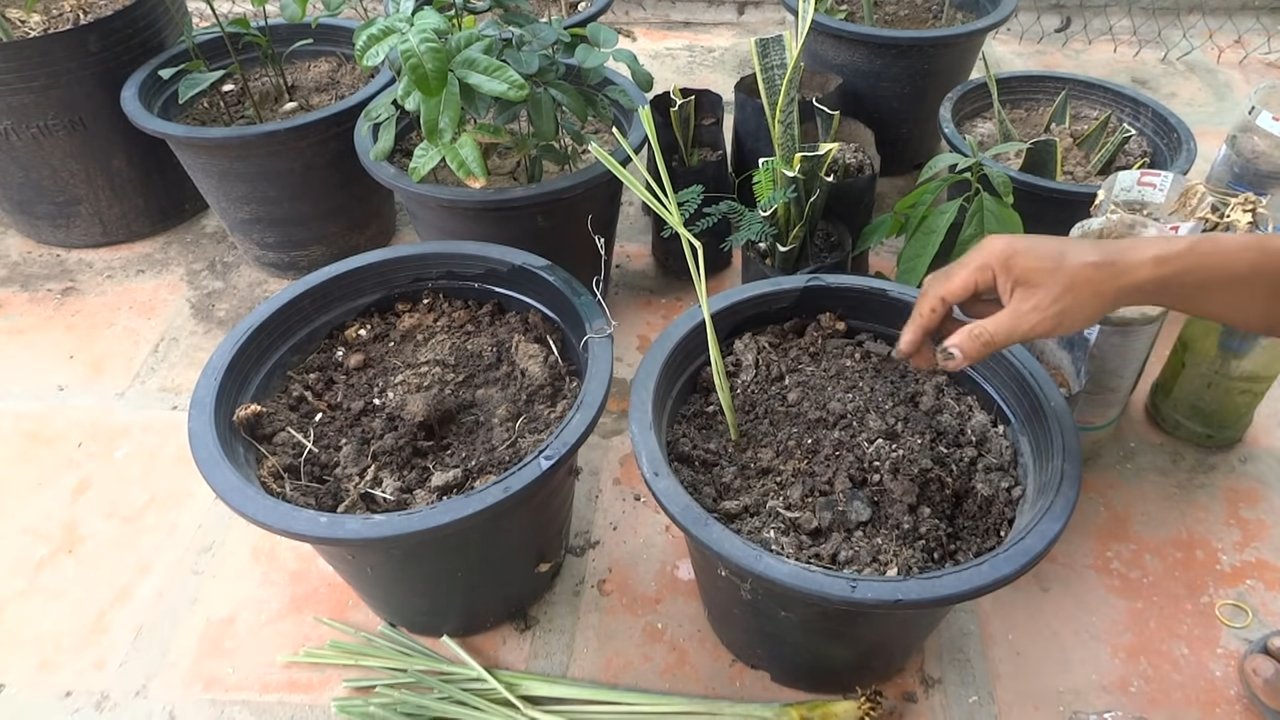Growing Lemongrass Indoors might seem like a tropical dream reserved for sun-drenched gardens, but I’m here to tell you it’s absolutely achievable, even if you’re miles away from Southeast Asia! Have you ever craved that vibrant, citrusy flavor in your Thai curry or soothing lemongrass tea, only to find the grocery store stalks looking a little…sad? Well, imagine having a fresh, thriving supply right on your windowsill!
Lemongrass, deeply rooted in Asian culinary traditions and revered for its medicinal properties, has been used for centuries. From flavoring dishes to repelling insects, this fragrant herb is a powerhouse. But you don’t need a sprawling farm to enjoy its benefits.
In today’s busy world, convenience is key, and that’s where this DIY guide comes in. Learning how to grow lemongrass indoors not only provides you with fresh ingredients but also adds a touch of greenery and a refreshing aroma to your home. Plus, it’s incredibly rewarding to nurture your own little herb garden! I’m going to share some simple, effective tricks and hacks that will have you harvesting your own lemongrass in no time. So, let’s ditch the wilted store-bought stalks and embark on this exciting journey of growing lemongrass indoors!

Growing Lemongrass Indoors: A DIY Guide for Fresh Flavor All Year Round
Hello, dear garden friends! Have you ever wished you could have the fresh, lemony scent and taste of lemongrass always on hand, no matter the weather outside? Then you’ve come to the right place! I’ll show you how you can easily grow lemongrass in your own four walls. It’s easier than you think and brings a piece of the exotic into your kitchen.
Why Grow Lemongrass Indoors?
Lemongrass is not only a great ingredient for Asian dishes but also a beautiful houseplant. Here are a few reasons why I love to grow lemongrass indoors:
- Fresh ingredients always on hand: No more annoying searches at the supermarket when you want to cook a recipe with lemongrass.
- Decorative houseplant: The long, green leaves are a real eye-catcher and bring life to any room.
- Aromatherapy: The scent of lemongrass is calming and refreshing.
- Easy propagation: From one stalk of lemongrass, you can easily grow new plants.
- Fewer pests: Indoors, lemongrass is less susceptible to pests than in the garden.
What You’ll Need for Growing Lemongrass Indoors
Before we get started, here is a list of all the things you’ll need:
- Lemongrass stalks: Preferably from an Asian market or a well-stocked supermarket. Make sure the stalks look healthy and have no brown spots.
- A glass or a vase: For rooting the stalks.
- A planter: With enough space for root growth.
- Potting soil: A good, well-draining potting soil is ideal.
- Water: Preferably low-lime water or rainwater.
- A sunny location: Lemongrass loves the sun!
- Optional: Liquid fertilizer: For an optimal supply of nutrients.
Rooting Lemongrass: A Step-by-Step Guide
Rooting is the first and most important step. Don’t worry, it’s really child’s play!
- Prepare the stalks: Cut off the top ends of the lemongrass stalks, leaving only about 10-15 cm (4-6 inches). Remove the outer, dry leaves to prevent rotting.
- Place in water: Fill a glass or vase with water and place the prepared stalks inside. Make sure the bottom ends of the stalks are well-covered with water.
- Choose a location: Place the glass in a bright, warm spot, but avoid direct sunlight. A windowsill is ideal.
- Change the water: Change the water every 1-2 days to prevent the formation of bacteria.
- Observe the roots: After about a week, the first roots should appear. Be patient, it can also take a little longer.
- Wait until the roots are long enough: Wait until the roots are about 5-7 cm (2-3 inches) long before planting the stalks in soil.
Planting Lemongrass: Here’s How
Once the roots are sufficiently developed, we can plant the lemongrass.
- Prepare the planter: Choose a planter with enough space for root growth. A diameter of at least 20 cm (8 inches) is ideal. Make sure the container has drainage holes so excess water can run off.
- Fill with soil: Fill the planter with good, well-draining potting soil. Leave about 2-3 cm (1 inch) of space to the rim.
- Insert the lemongrass: Make a small hole in the soil and carefully place the rooted lemongrass stalks inside. Be careful not to damage the roots.
- Fill with soil: Fill the hole with soil and press it down lightly.
- Water in: Water the lemongrass thoroughly until water runs out of the drainage holes.
Caring for Lemongrass Indoors
For your lemongrass to thrive, proper care is crucial.
- Location: Lemongrass loves the sun! Place it in the brightest possible location, ideally a south-facing window. If the lemongrass does not get enough light, the leaves will become pale and thin.
- Watering: Water the lemongrass regularly, but avoid waterlogging. The soil should always be slightly moist. In winter, when growth is slower, you can water a little less.
- Fertilizing: During the growing season (spring and summer), you should fertilize the lemongrass every 2-4 weeks with a liquid fertilizer for herbs or vegetables.
- Pruning: Regularly prune the leaves to encourage growth. You can use the cut leaves for cooking or dry them for tea.
- Repotting: When the lemongrass has outgrown its planter, you should transplant it into a larger container.
- Overwintering: Lemongrass is not winter-hardy. In winter, you should place it in a bright, cool spot and water it less.
Common Problems and Solutions
Problems can also arise when growing lemongrass indoors. Here are a few common problems and how you can solve them:
- Yellow leaves: Yellow leaves can be a sign of too little light, too much water, or a nutrient deficiency. Check the location, watering, and fertilization.
- Brown leaf tips: Brown leaf tips can be caused by dry air. Spray the leaves regularly with water or place a tray of water near the plant.
- Pests: Indoors, lemongrass is less susceptible to pests than in the garden. If you do discover pests, you can combat them with a biological pesticide.
Harvesting and Using Lemongrass
Harvesting lemongrass is very simple. Just cut the stalks near the base. You can use the stalks fresh or dry them and store them for later.
- Fresh use: Cut the stalks into thin slices and add them to soups, curries, or teas.
- Dried use: Dry the stalks in an airy place or in the oven at a low temperature. Use the dried stalks for teas or as a spice.
Additional Tips and Tricks
Here are a few more tips that can help you with growing lemongrass indoors:
Be patient: Lemongrass takes time to grow. Be patient and don’t give up!
Use rainwater: Rainwater is ideal for watering lemongrass as it is low in lime.
Rotate the planter regularly: Rotate the planter regularly so that the lemongrass grows evenly.
Avoid drafts: Lemongrass does not like drafts.

Conclusion
So, there you have it! Growing lemongrass indoors isn’t just a whimsical gardening project; it’s a practical, aromatic, and surprisingly simple way to bring a touch of Southeast Asian sunshine into your home. Forget those wilted, overpriced stalks at the grocery store. With a little patience and the right approach, you can have a thriving supply of fresh, fragrant lemongrass right at your fingertips.
Why is this DIY trick a must-try? Because it empowers you to control the quality and freshness of your ingredients. Imagine the vibrant flavor and aroma of freshly harvested lemongrass infusing your curries, soups, and teas. It’s a game-changer! Plus, it’s incredibly rewarding to nurture a plant from a simple stalk to a flourishing herb.
Beyond the basic method we’ve outlined, there’s plenty of room for experimentation. Try different potting mixes to see what works best for your environment. Some gardeners swear by a blend of coco coir, perlite, and compost, while others prefer a standard potting mix amended with extra drainage. You can also experiment with different light sources. While a sunny windowsill is ideal, a grow light can be a lifesaver during the darker months.
Consider the variety of lemongrass you’re growing. While most commercially available lemongrass is *Cymbopogon citratus*, there are other varieties with slightly different flavors and growth habits. Do some research and see if you can find a variety that suits your specific needs and preferences.
And don’t be afraid to get creative with how you use your homegrown lemongrass. Beyond culinary applications, lemongrass can be used to make refreshing teas, fragrant bath soaks, and even natural insect repellents. The possibilities are endless!
We wholeheartedly encourage you to give this DIY trick a try. It’s a fun, educational, and ultimately delicious way to connect with nature and enhance your culinary creations. We are confident that you will find that **growing lemongrass indoors** is easier than you think.
But the real magic happens when you share your experiences. Did you encounter any challenges along the way? Did you discover any helpful tips or tricks that we didn’t mention? We want to hear all about it! Share your photos, stories, and insights in the comments below. Let’s create a community of indoor lemongrass growers and learn from each other. Together, we can unlock the full potential of this amazing herb and bring a little bit of sunshine into our homes, one stalk at a time. So, grab a stalk, get planting, and let the lemongrass adventure begin!
Frequently Asked Questions (FAQ)
1. What kind of lemongrass should I use to start growing indoors?
The most common type of lemongrass available in grocery stores and nurseries is *Cymbopogon citratus*. This is the variety you’ll want to use for starting your indoor lemongrass garden. Look for stalks that are firm, green, and free from blemishes. Avoid stalks that are dried out, yellowing, or showing signs of rot. Ideally, choose stalks that still have a bit of the root end attached, as this will increase your chances of success. If you can find organic lemongrass, that’s even better, as it will minimize the risk of introducing pesticides or other harmful chemicals into your indoor garden.
2. How long does it take for lemongrass to root in water?
Generally, you can expect to see roots emerging from your lemongrass stalks within 2-4 weeks. However, the exact timeframe can vary depending on factors such as water temperature, light exposure, and the overall health of the stalks. Be patient and change the water every few days to keep it fresh and prevent the growth of bacteria. Once the roots are about an inch or two long, you can transplant the lemongrass into a pot with well-draining soil.
3. What kind of soil is best for growing lemongrass indoors?
Lemongrass thrives in well-draining soil that is rich in organic matter. A good option is to use a standard potting mix amended with perlite or vermiculite to improve drainage. You can also add compost or other organic matter to provide essential nutrients. Avoid using heavy clay soils, as they can retain too much moisture and lead to root rot. The ideal pH for lemongrass is between 6.0 and 7.0.
4. How much sunlight does lemongrass need indoors?
Lemongrass needs at least 6-8 hours of direct sunlight per day to thrive. A south-facing window is usually the best option, but an east- or west-facing window can also work. If you don’t have enough natural light, you can supplement with a grow light. Position the grow light about 6-12 inches above the plants and keep it on for 12-16 hours per day. Insufficient light can lead to weak, leggy growth and reduced flavor.
5. How often should I water my indoor lemongrass plant?
Water your lemongrass plant regularly, keeping the soil consistently moist but not waterlogged. Allow the top inch of soil to dry out slightly between waterings. During the warmer months, you may need to water more frequently than during the cooler months. Be sure to provide adequate drainage to prevent root rot. A good rule of thumb is to water thoroughly until water drains out of the bottom of the pot.
6. How do I harvest lemongrass from my indoor plant?
To harvest lemongrass, simply cut off the stalks near the base of the plant. Use a sharp knife or scissors to make a clean cut. You can harvest individual stalks as needed, or you can harvest the entire plant at once. If you harvest the entire plant, leave a few inches of the base intact so that it can regrow. The lower, thicker part of the stalk is the most flavorful.
7. Can I grow lemongrass from seed indoors?
Yes, you can grow lemongrass from seed indoors, but it’s generally more challenging than starting from stalks. Lemongrass seeds can be slow to germinate and require consistent moisture and warmth. If you choose to grow from seed, start the seeds indoors 6-8 weeks before the last expected frost. Sow the seeds in a seed-starting mix and keep them moist and warm. Once the seedlings are large enough to handle, transplant them into individual pots.
8. My lemongrass plant is turning brown. What’s wrong?
There are several reasons why your lemongrass plant might be turning brown. Overwatering or underwatering are common culprits. Check the soil moisture and adjust your watering accordingly. Insufficient sunlight can also cause browning. Make sure your plant is getting enough light. Nutrient deficiencies can also lead to browning. Fertilize your plant regularly with a balanced fertilizer. Finally, pests or diseases can also cause browning. Inspect your plant for signs of pests or diseases and treat accordingly.
9. How do I fertilize my indoor lemongrass plant?
Fertilize your lemongrass plant every 2-4 weeks during the growing season (spring and summer) with a balanced liquid fertilizer. Follow the instructions on the fertilizer label. Avoid over-fertilizing, as this can damage the plant. You can also amend the soil with compost or other organic matter to provide slow-release nutrients.
10. Can I move my indoor lemongrass plant outdoors during the summer?
Yes, you can move your indoor lemongrass plant outdoors during the summer, but be sure to acclimate it gradually to the outdoor conditions. Start by placing the plant in a shady spot for a few hours each day, gradually increasing the amount of sunlight it receives. Bring the plant back indoors before the first frost.




Leave a Comment